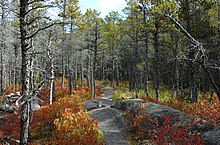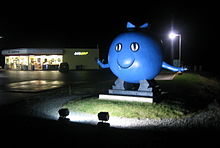en
names in breadcrumbs


The black bear, moose, eastern cottontail, and white-tailed deer feed on the foliage. Domestic sheep commonly avoid low sweet blueberry browse. Flowers and fruit are readily eaten by a wide variety of birds and mammals. Mammal species include black bear, red fox, raccoon, red-backed vole, white-footed mouse, fox squirrel, red squirrel, eastern spotted skunk, gray fox, and many species of chipmunks and mice. Birds include ptarmigan, American robin, common crow, wild turkey, ruffed grouse, spruce grouse, gray catbird, brown thrasher, rufous-sided towhee, northern mockingbird, black-capped chickadee, red-cockaded woodpecker, starling, cardinal, scarlet tanager, Canada goose, herring gull, whimbrel, quail, and thrushes, and eastern bluebird. (USDA FEIS, 1991)
The reproductive success of black bears has been particularly correlated to annual blueberry crops. Poor blueberry crops can limit black bear reproductive success as well as overall survival in some regions. Bear depredations such as damage to crops and beehives and livestock losses typically increase during poor berry years. (USDA FEIS, 1991)
USA: CT , DE , IL , IN , IA , ME , MD , MA , MI , MN , NH , NJ , NY , OH , PA , RI , TN , VT , VA , WV , WI (NPIN, 2007)
Canada: MB , NB , NL , NS , ON , PE , QC , SK (NPIN, 2007)
Native Distribution: Lab. to Sask., s. to New England, DE, WV, OH, n. IL & IA (NPIN, 2007)
USDA Native Status: L48(N), CAN(N), SPM(N) (NPIN, 2007)
This species is highly fire resilient in both natural and artificial regimes. Fire treatment may be used to enhance fruiting, which is low the first season and high for the following three. The causility is debated and may range from increased nutrients, favorable pH, increased heat from black soil, and reduction of competitors. (USDA FEIS, 1991)
Flowers are white and bell-like. (Hultman, 1978) Flowers have 10 stamens. Racemes (common pedicels) are short, about 5-flowered. The corolla is green, or greenish bordered with red and cylindric-urn-shaped. (Peattie, 1930) Small, white, pink-tinged, bell-shaped flowers. (NPIN, 2007) Flowers are white, 5-parted, and urn-shaped. The lobes are shorter than the tube. (UW, 2009)
Fruit Dark blue berries are covered with a white powder, have many seeds, and are edible. (Hultman, 1978) The fruit are oblate-spheroid a bloom. They are sweet and edible. (Peattie, 1930) Fruit are blue, shiny berries with many seeds. (UW, 2009)
Leaves are egg-shaped and may have a few bristle-tipped teeth. They become leathery with age. (Hultman, 1978) Leaf margins are entire. Leaves are oblong-lanceolate to lanceolate, spatulate or elliptic, acute, and narrowed at base. The margin is sharply serrulate, sparingly pubescent on both surfaces at first, finally smooth or nearly smooth. (Peattie, 1930) Glossy foliage turns from red-green in spring to dark blue-green in summer to maroon-purple in fall. (NPIN, 2007) Leaves are deciduous, smooth, and narrowly elliptical with tiny, sharp teeth. (UW, 2009)
Stems branches and branchlets are wrinkled, yellowish green, and pubescent at least in lines. (Peattie, 1930) Multiple stems have twiggy branches. (NPIN, 2007)
Plant is up to 3' tall. (Hultman, 1978) Plant is less than a meter tall, being 25-50 cm tall. (Peattie, 1930) The plant is usually 6" to 2' tall and wide. (NPIN, 2007) Plants can be 2"-14" tall. (UW, 2009)
Flowers are 3/8" long. (UW, 2009)
Fruit 9-15 mm thick. (Peattie, 1930)
Leaves 1.5-2". (Hultman, 1978)
Fruit is an excellent source of vitamin C, natural sugars, niacin, and manganese. The berries are relatively high in carbohydrates and soluble solids but contain little sodium or fat. Fruit averages approximately 41 calories per 0.5 cup, with sugar concentration ranging from 0.03 to 0.34 percent. Accordingly the overall nutrient value is rated as moderately low. (USDA FEIS, 1991)
Vaccinium angustifolium, commonly known as the wild lowbush blueberry, is a species of blueberry native to eastern and central Canada (from Manitoba to Newfoundland) and the northeastern United States, growing as far south as the Great Smoky Mountains and west to the Great Lakes region.[3][4] Vaccinium angustifolium is the most common species of the commercially used wild blueberries and is considered the "low sweet" berry.[5]
The species epithet angustifolium is a combination of the Latin words angustum meaning 'narrow', and folium meaning 'leaf'.

Vaccinium angustifolium is a low spreading deciduous shrub growing 5 to 60 cm (2 to 24 in) tall.[6] Its rhizomes can lie dormant up to 100 years, and when given the adequate amount of sunlight, soil moisture, and oxygen content they will sprout. The leaves are glossy blue-green in summer, turning a variety of reds in the fall. The leaf shape is broad to elliptical. Buds are brownish red in stem axils. The flowers are white or pink,[7] bell-shaped, 4 to 6 mm (0.16 to 0.24 in) long. The fruit is a small sweet dark blue to black berry, full of antioxidants and flavonoids. This plant grows best in wooded areas, old abandoned farmyards or open areas with well-drained acidic soils. In some areas it produces natural blueberry barrens, where it is practically the only species covering large areas.[8]
Several buds may be on a healthy stem, and each bud can open up and have several blossoms. A blueberry field that has full plant coverage can have as many as 150 million blossoms per acre.
The Vaccinium angustifolium plant is fire-tolerant, and its numbers often increase in an area following a forest fire. Traditionally, blueberry growers burn their fields every few years to eliminate shrubs and fertilize the soil. In Acadian French, a blueberry field is known as a brûlis (from brûlé 'burnt') because of that technique, which is still in use.
The lowbush blueberry is native to central and eastern Canada as well as north-central and eastern United States.[9] In its native habitat the plant grows in open conifer woods, old fields, and sandy or rocky balds.[10]
Glacier ice from the Ice Age sculpted the Maine landscape and is responsible for creating some of the most productive Vaccinium angustifolium habitat.[11]
Many animals feed on the fruit and foliage of the lowbush berry, some of which include black bears, racoons, foxes, white-tailed deer and birds.[6]
Its leaves are also popular among caterpillars. It is a larval host to the pale tiger moth, the peppered moth,[12] the chain-dotted geometer, the saw-wing moth, the blueberry gray moth, the mousy angle moth,[13] Caloptilia vacciniella, Andromeda underwing, the shadowy arches, the two-spot dart,[14] the dingy cutworm moth, the speckled cutworm,[15] the decorated owlet, the pirate looper, Norman's dart, the gray swordgrass moth, the pink-edged sulphur butterfly, the pawpaw sphinx moth, and the blueberry leaftier moth.
Vaccinium angustifolium has a two year production cycle.[16] The first year is known as the vegetative year and the second is known as the fruit-bearing year.
In order to be productive each year, most farmers divide their land to have half their crop in the vegetative year while the other half is in the fruit-bearing year.[17]
Native Americans regularly burned away trees and shrubs in parts of eastern Maine to stimulate blueberry production. Modern farmers use various methods of burning or mowing to accomplish this.[18] There are several methods growers use to stimulate blueberry production on their land, such as burning the land or using a flail mower, bush hog, lawnmower, etc. to cut the plants off as close to the ground as possible without scalping the land. These procedures are used to promote the spreading of rhizomes under the soil. Some growers use a sickle bar mower in the fall after the crop has been harvested to mow the plants off, leaving roughly 1 to 2 inches of stem so the growers can then burn the remainder of the plants in the spring, using less fuel for the fire.
Farmers then treat their crops with pesticides to control weeds and insects.[19] The fields are then left for new growth to emerge, develop, and flourish for the remainder of the year.
During the harvest or fruit bearing year, blueberry growers rent honey bee hives to put in their fields for pollination. These hives are placed in the fields at a density range of anywhere from 1-8 hives per acre. The hives are placed in the fields at 10-20% bloom allowing the bees to have enough forage rather than going elsewhere to forage. Hives are left in blueberry fields for 2 weeks on average, allowing the bees to pollinate the variety of clones in the field, all of which bloom at different times during the two-week period.
Some growers also use bumble bees as well in hopes of maximum pollination. Bumblebees will fly in colder and wetter weather conditions than the honey bee will, and they also pollinate in a different way than the honey bee. Bumblebees can sonicate the flowers, which releases pollen from deep inside the poricidal anthers. This is known as buzz-pollination.
Blueberry growers also rely on many wild bees for pollination, including solitary bees like Andrena carlini and Colletes inaequalis.[20]

The lowbush blueberry is the state fruit of Maine,[21] and the wild low bush blueberry is also the Nova Scotian Provincial Berry.[22] Oxford, Nova Scotia is nicknamed "Wild Blueberry Capital of Canada."[23] Maine's state dessert is blueberry pie made with wild blueberries.[24]
Vaccinium angustifolium, commonly known as the wild lowbush blueberry, is a species of blueberry native to eastern and central Canada (from Manitoba to Newfoundland) and the northeastern United States, growing as far south as the Great Smoky Mountains and west to the Great Lakes region. Vaccinium angustifolium is the most common species of the commercially used wild blueberries and is considered the "low sweet" berry.